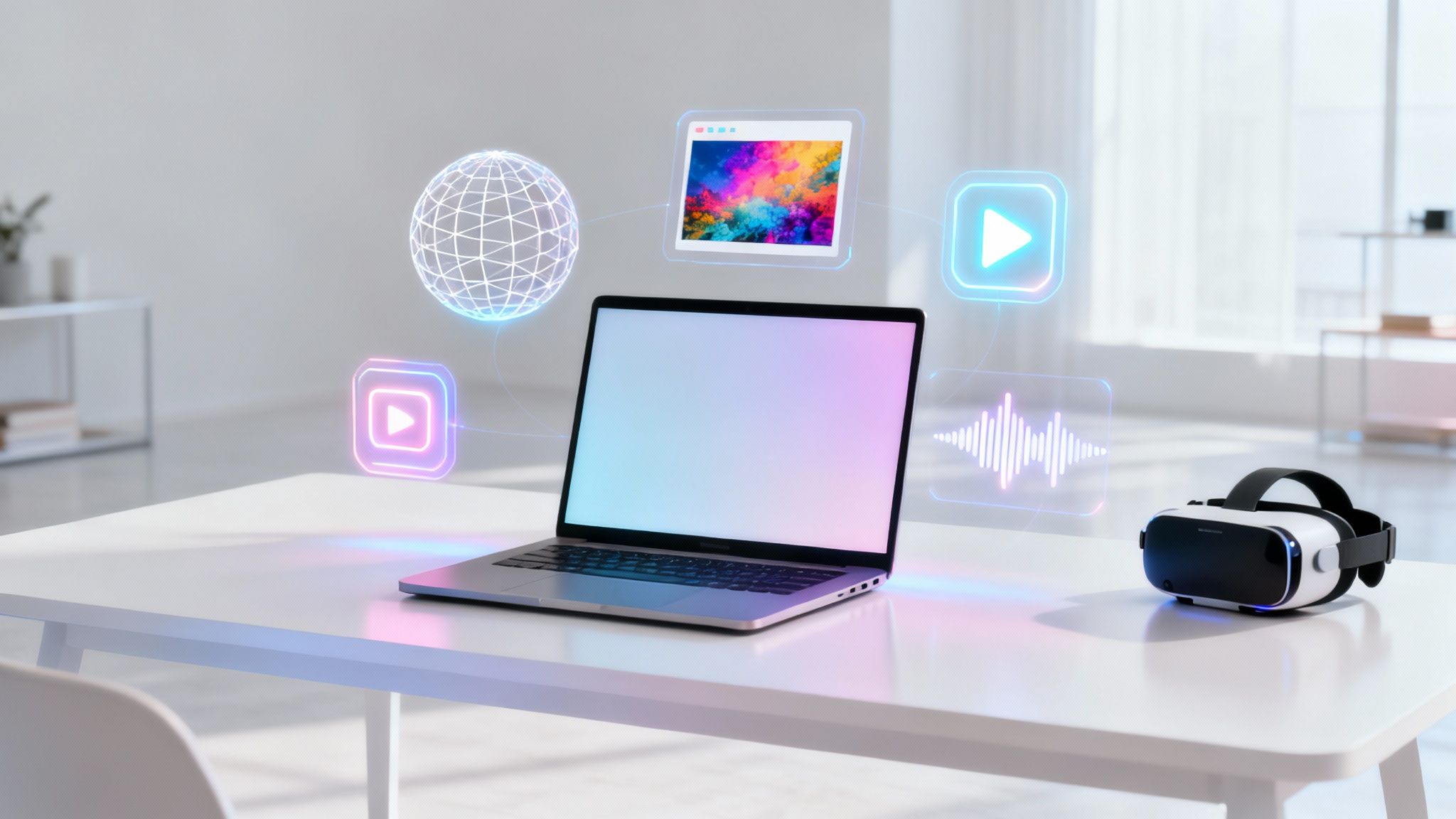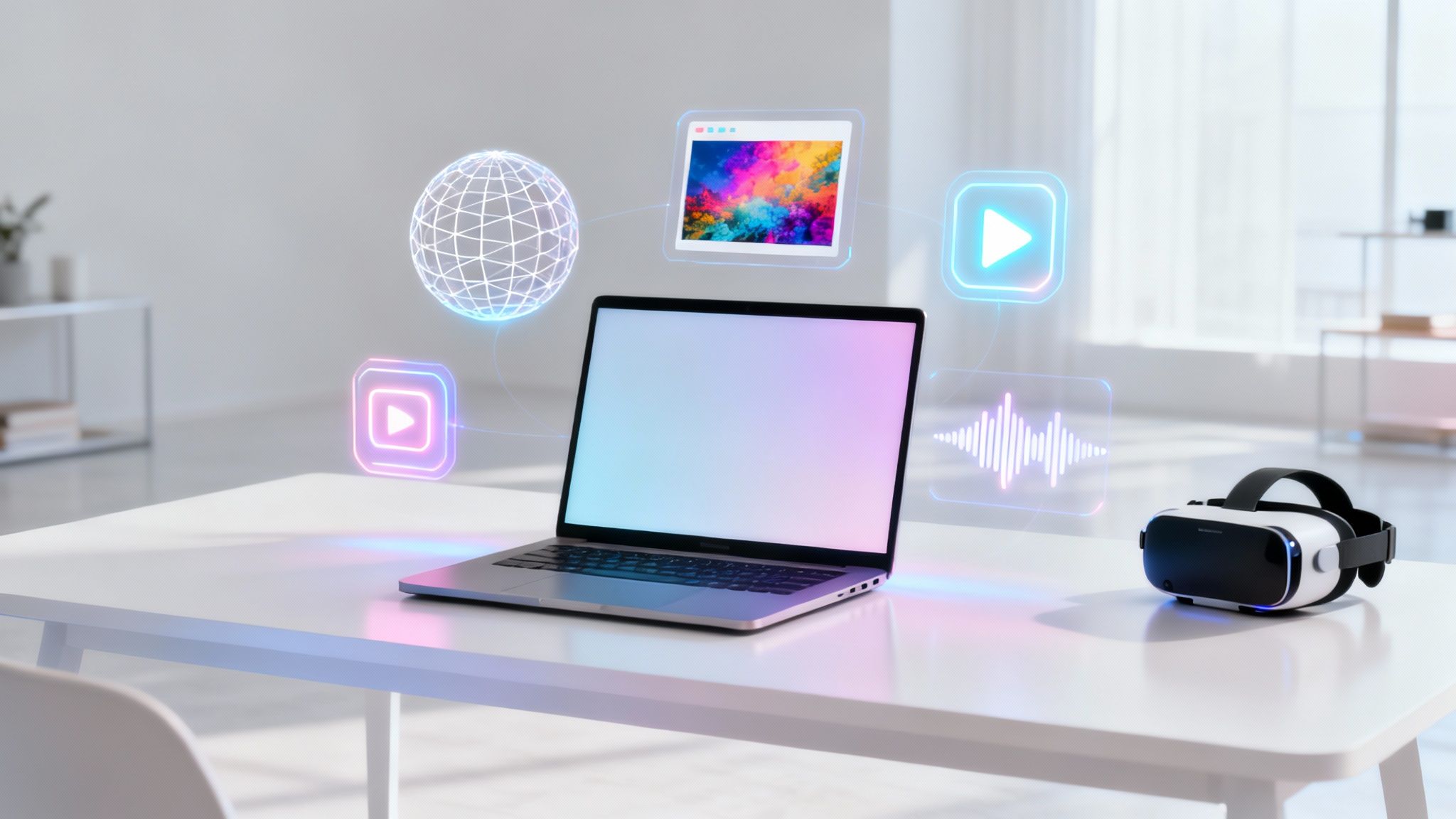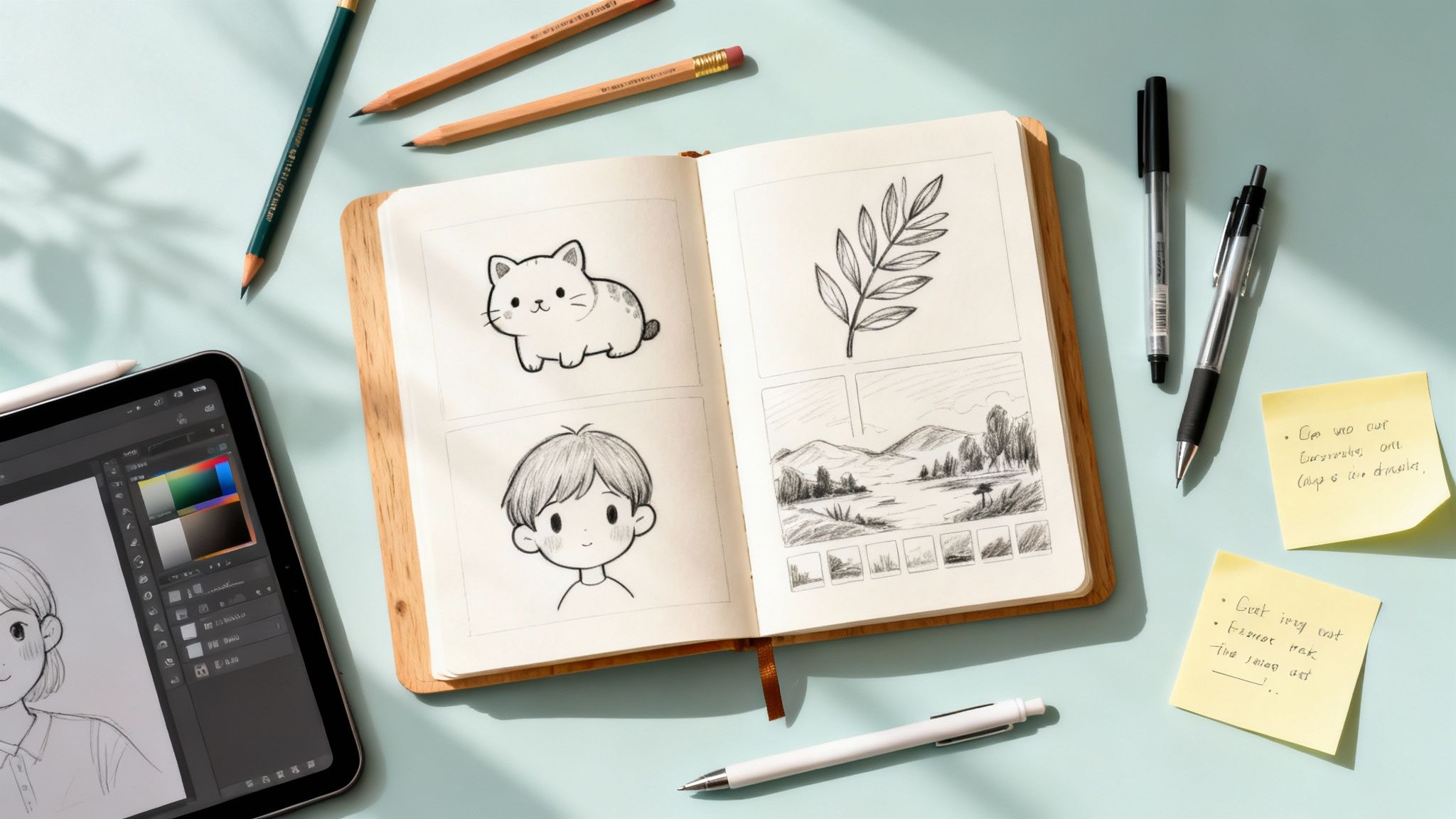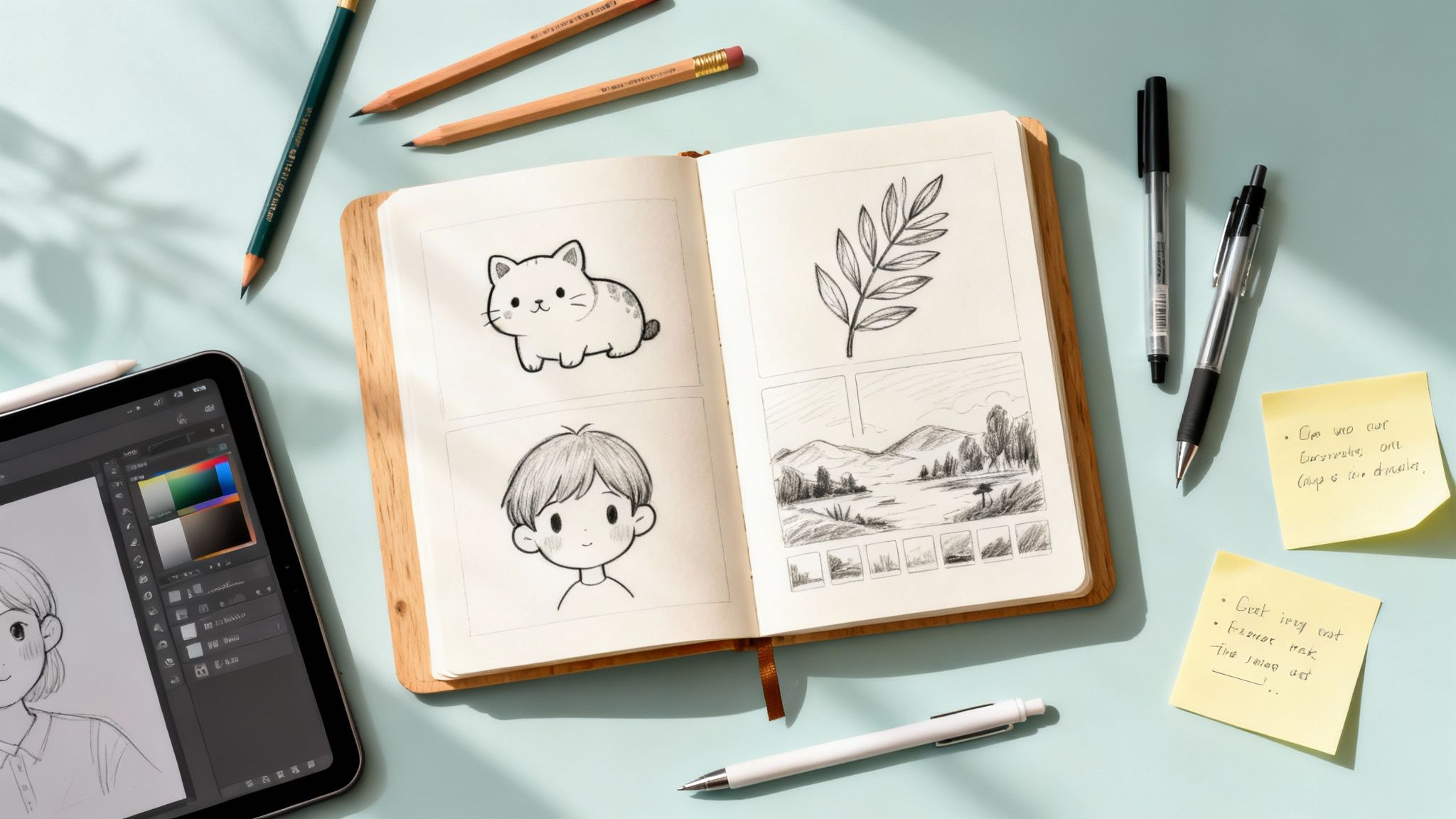Bringing any visual idea to life requires more than just talent—it demands the right toolkit. Whether you're building photorealistic 3D models or producing cinematic videos, digital content creation tools are the engines powering modern creative work. For any enterprise, using a compliant and secure platform is paramount.
If you haven't generated anything with an AI-powered system yet, you can experience a responsible, enterprise-grade solution firsthand. We encourage you to try Virtuall’s Creative AI OS for free and see the difference a single, secure platform makes—from the first concept to the final render.
Unlocking Creativity with the Right Digital Tools

This guide will walk you through the essential software that makes up a complete creative arsenal. But more importantly, it introduces a smarter, more secure way to work by bringing everything together in an integrated Creative AI OS like Virtuall.
The path from a rough sketch to a polished asset is almost never a straight line. It's a complex dance between different skills, software, and people. For decades, this process has been completely fragmented, forcing artists to constantly jump between separate applications for modelling, texturing, animating, and editing.
This old-school, disjointed approach doesn't just slow things down. It opens the door to all sorts of problems with version control, asset management, and data security. Every time a file gets exported from one program and imported into another, you’re rolling the dice on errors, data loss, or compatibility nightmares.
The Problem with Disconnected Workflows
A fragmented creative pipeline creates some very real headaches for teams, especially in a business setting where efficiency and security are non-negotiable. Relying on a patchwork of specialised tools creates silos that kill collaboration and add needless complexity. The result is often major inefficiencies that blow up project timelines and budgets.
Here are the key issues that pop up when your tools don't talk to each other:
- Inefficient Asset Management: Creative assets—3D models, textures, video clips—end up scattered across different platforms and local hard drives. This makes them a nightmare to track, version, and reuse.
- Collaboration Barriers: Trying to share feedback becomes a clumsy mess of sending files back and forth over email or chat. It’s slow, confusing, and leads to endless delays.
- Security Vulnerabilities: When you're moving sensitive intellectual property between various cloud services or personal computers, you're exposing it to serious security risks and making compliance a mess.
- Increased Operational Overhead: Juggling multiple software licences, updates, and user permissions for a growing team is both a huge time-sink and a serious expense.
As creative projects get more ambitious, having a cohesive, secure, and collaborative environment stops being a nice-to-have. It becomes a necessity. The real cost of a fragmented workflow isn't just wasted time; it's lost creative momentum and increased business risk.
This guide will break down the core categories of digital content creation tools and show you how a unified approach, powered by a Creative AI OS, can finally solve these persistent challenges. It’s about letting your team get back to what they do best: creating exceptional visual content.
Making Sense of the Creative Software Jungle
Diving into creative software can feel like stepping into a labyrinth. But it’s simpler than it looks. Just think of it like a builder’s toolbox—you have hammers for nails and saws for wood. Each digital content creation tool has its job, and knowing which one to grab is the first step to building something great.
The whole landscape really just boils down to a handful of core disciplines. Each is built to tackle a specific piece of the production puzzle, from sculpting entire digital worlds to polishing the final cut of a video. Getting a handle on these categories is the key to assembling a powerful and efficient creative toolkit.
To get a clearer picture, let's group these tools by what they actually do. This helps you see where each one fits and how they work together on a real-world project. Most professional work isn't done in a single piece of software; it's a relay race, with assets passed from one specialist tool to the next.
Here’s a quick overview of the main tool categories and what they're used for in the creative trenches.
Key Digital Content Creation Tool Categories
This specialisation is exactly why creative pipelines have always felt so fragmented. An artist might build a 3D model in one app, paint textures on it in another, and then jump into a third to animate it. It works, but it’s often a slow, clunky process.
The Tools Market is Booming
It’s not just a feeling—the demand for these specialised tools is exploding. Businesses of all sizes are finally realising that high-quality visual content isn't a luxury; it's essential. This trend is happening everywhere, but it’s especially noticeable in digitally savvy markets.
Take Denmark, for example. The digital content creation market there is set to hit USD 224.36 million by 2025. What's driving it? Small and medium-sized businesses jumping on cloud-based creative tools. With a projected annual growth rate of 13.0%, the Danish market shows just how fast companies are adopting more advanced creative tech. You can dig deeper into the numbers in this digital content creation market report.
This growth highlights a massive shift: knowing your way around these tools is no longer a niche skill for artists. It’s a core business advantage. As more companies beef up their creative capabilities, the ones who can produce amazing visuals without wasting time and money will pull ahead.
Once you understand what each type of tool does best, you can make smarter calls for your own projects. Whether you're a one-person shop or leading a big team, this foundational knowledge is everything. It helps you choose the right software and sets you up for a much more integrated way of creating.
The Shift to Integrated AI-Powered Platforms
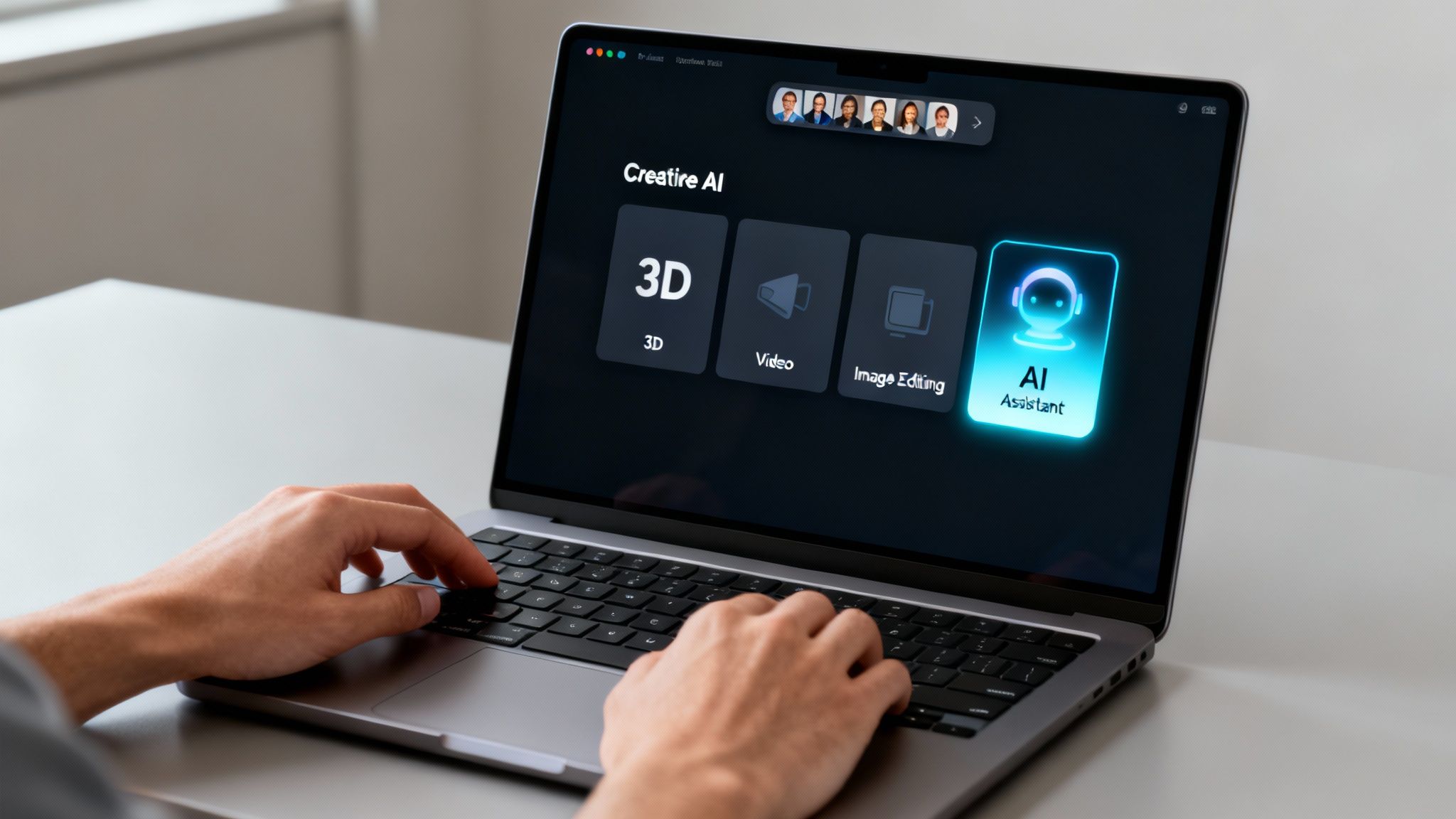
For years, the creative process felt like a frustrating maze. Artists and designers had to constantly jump between a messy collection of apps for modelling, texturing, animating, and editing. This fragmented workflow wasn't just slow; it actively sabotaged collaboration and brought innovation to a crawl.
Thankfully, that old, disjointed model is on its way out. A new wave of integrated creative ecosystems is emerging to fix the problem. These unified Software as a Service (SaaS) platforms pull all the essential digital content creation tools into a single, cohesive environment, completely changing how teams bring ideas to life.
This shift is especially clear in places like Denmark, where the SaaS industry is booming. The Danish SaaS market is valued at USD 0.57 billion in 2025 and is projected to hit USD 1.02 billion by 2030, growing at a compound annual rate of 12.54%. Small and medium-sized businesses are driving this trend, attracted by the low barrier to entry and easy scalability of SaaS solutions.
The Power of a Creative AI Operating System
Leading this evolution are platforms best described as a Creative AI OS. Think of it less like a single tool and more like a central command centre for your entire creative operation. A platform like Virtuall uses artificial intelligence to automate mundane tasks, unlock new creative avenues, and simplify every part of managing your assets.
Instead of wrestling with file formats and version control, teams can finally work together in one shared space. This integrated approach is about more than just convenience. It creates a fluid, uninterrupted workflow where creativity can actually flourish.
By bringing every stage of production under one roof, a Creative AI OS removes the technical barriers that have long frustrated creative professionals. It lets artists focus on their vision, not the logistics of juggling a dozen different software licences.
This unified model also gets everyone working from the same playbook. Assets are centralised, feedback is instant, and collaboration happens in real-time, right on the visual content itself.
Boosting Efficiency and Ensuring Consistency
One of the first things you'll notice with an integrated platform is the dramatic jump in team efficiency. When every tool you need is in one place, the time once lost exporting, importing, and converting files can be poured back into the creative work itself.
This consolidated environment also makes it far easier to maintain brand and project consistency. Since all assets live in a central library, ensuring everyone is using the correct versions of models, textures, and brand elements becomes simple. This kills the costly, time-sucking errors that pop up in disorganised workflows.
For a concrete example of this integration, look at specialised AI social media post generator tools. They show how specific AI capabilities are being built into broader platforms to streamline content generation for marketing.
Enterprise-Grade Security and Scalability
For any serious business, relying on a patchwork of consumer-grade tools is a massive security risk. Intellectual property can get exposed, and staying compliant with data protection rules becomes a logistical nightmare.
An enterprise-focused Creative AI OS is built with security at its core. It offers robust access controls, data encryption, and clear governance to protect your most valuable assets, making it a responsible choice for any business.
These platforms are also built to scale. Whether you're a small studio or a massive enterprise, a cloud-based OS lets you add users, expand storage, and access more powerful features without a huge upfront hardware investment. This makes high-end digital content creation tools more accessible than ever, levelling the playing field for teams everywhere. You can explore our guide on other specific AI tools for content creation to see how different technologies are coming together.
How to Choose the Right Tools for Your Projects
Picking the right digital content tools can feel like navigating a maze. With a flood of specialised apps and platforms, the smartest move is to step back and figure out exactly what you need. A little forethought now ensures you build a toolkit that not only fixes today's problems but also grows with you.
First thing’s first: what are you actually making? The tools for a complex 3D animation are worlds apart from what you’d use for simple web graphics. Pinpointing your main output—whether it’s cinematic video, an interactive AR experience, or a photorealistic product render—instantly cuts through the noise and points you in the right direction.
Beyond the what, think about the how complex. A quick social media video might just need a single, user-friendly editing app. But a high-fidelity game asset? That’s going to require a whole chain of powerful, specialised tools for sculpting, texturing, rigging, and animation.
Evaluating Your Team and Workflow
Once you’ve got your project needs locked down, look at your team. How many people are jumping on a project at once? Do they need to work together in real-time, or is passing files back and forth okay? The answers will tell you whether you need a setup built for smooth collaboration.
A solo creator might be perfectly content juggling a few standalone desktop apps. But a team of ten spread across different locations needs a cloud-based home base that keeps assets organised and feedback simple. We're seeing this shift everywhere; over 50% of nonprofits now use AI to boost productivity, a trend that's just as strong in the creative world where team efficiency is everything.
Ask yourself these key questions about your workflow:
- Asset Management: Where will all your files, models, and textures live? A central system is your best defence against version-control chaos.
- Feedback Loop: How will your team give and track feedback? Look for tools with built-in commenting and markup features.
- Integration: Do the tools play nicely together? A clunky workflow that forces you to constantly export and import files is a major creativity killer.
Budget and Long-Term Scalability
Of course, budget is always a factor. Standalone software can hit you with big upfront costs or a mess of different subscription fees that add up fast. For teams, managing individual licences for dozens of people becomes a huge administrative and financial drain.
This is where integrated platforms, like a Creative AI OS, start to look really good. They usually run on a SaaS model, giving you predictable monthly costs and ditching the need for massive initial investments in software or hardware. It makes top-tier digital content creation tools accessible to businesses of any size.
A comparison of these two approaches makes the choice clearer.
Tool Selection Criteria Comparison
Ultimately, choosing your tools isn't just a technical decision; it's a strategic business one.
The goal is to find a solution that delivers the best return on investment by boosting productivity, keeping your work secure, and scaling with your ambitions.
Scalability is the final piece of the puzzle. The tools you pick today shouldn't just meet your current needs—they need to grow with your team and your projects. A cloud-native platform lets you add users, expand storage, and unlock more power as your business evolves. It's about building a future-proof foundation for all your creative work.
For a deeper look at specific solutions, you can check out guides on the top AI tools for content creation to see what aligns with your vision. And if your work is all about video, our guide to the best AI video generators offers more focused insights.
Streamlining Workflows with a Creative AI OS
It’s one thing to talk about the different digital content creation tools out there. It’s another to see how they actually fit together in a real project.
Let's walk through a common scenario to show how an integrated platform, like Virtuall’s Creative AI OS, can turn a frustrating, disjointed process into something smooth and fast.
Imagine your team needs to create a promotional video. But this isn't just a simple edit; it needs a complex, animated 3D product model with photorealistic textures. In a typical setup, this is a clunky relay race where the baton gets dropped—a lot.
The Old Way: A Fragmented Nightmare
First, the job lands with the 3D artist. They build the model in a specialised tool like Maya or Blender. After getting the basic shape approved, they export the file—probably as an OBJ or FBX—and hand it off to a texture artist.
That artist then has to import the model into a completely different program, maybe Substance Painter, to paint on the detailed materials. After hours of work, they export gigabytes of texture maps. Now, both the model and its textures go to an animator, who pulls everything into another piece of software to rig the model and create the motion.
Each of these handoffs is a potential point of failure.
Files get corrupted. Versions get mixed up. Feedback becomes a confusing mess of emails and screenshots. Finally, the rendered animation is sent to a video editor who composites it into the final cut, adding graphics and sound. The entire process involves at least four different software packages, endless file exports, and a massive risk of miscommunication.
This infographic really nails down the decision points for picking any tool, showing just how vital it is to match your software to what a project actually needs.
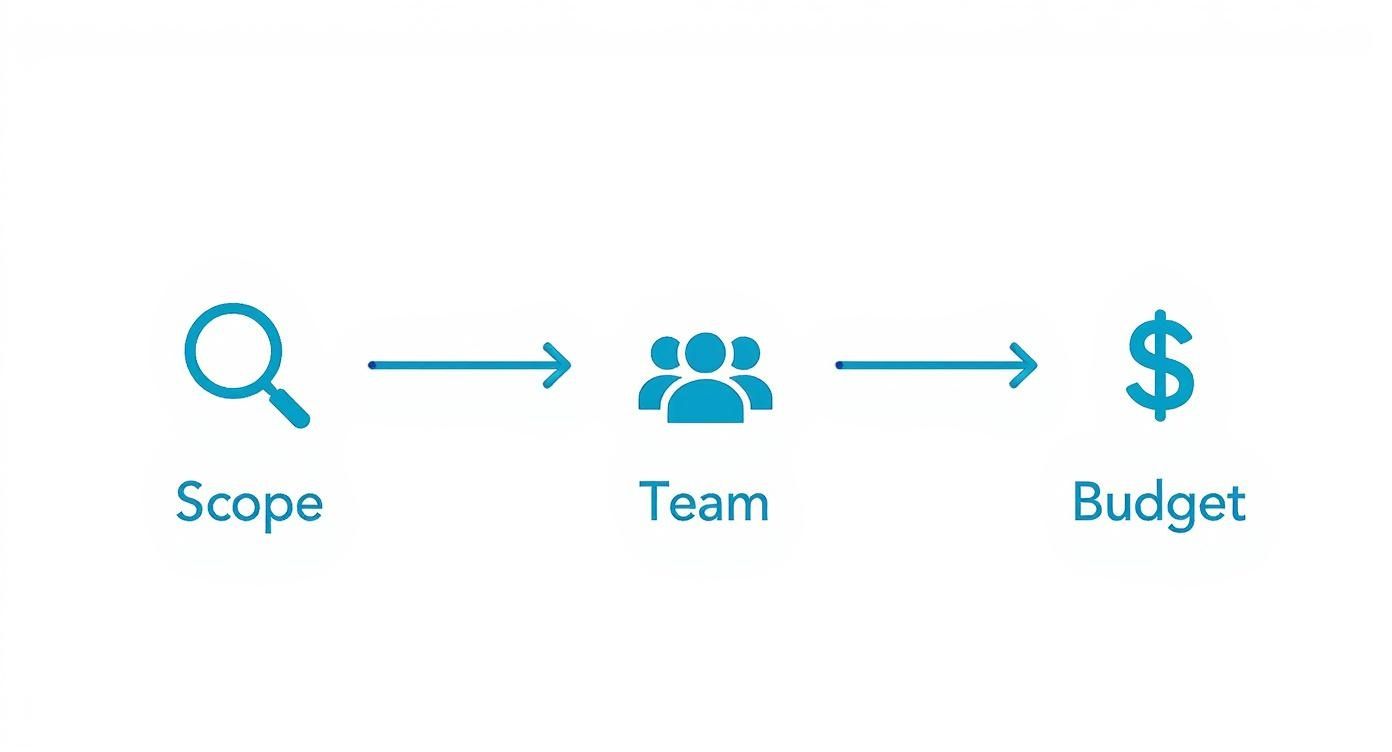
As you can see, a solid decision framework is foundational. It forces teams to think about the whole picture from the start, preventing exactly the kind of fragmented workflow we just described.
The New Way: A Unified Creative OS
Now, let's replay that same project inside a Creative AI OS. The entire workflow lives in a single, secure environment right in your browser. There are no disjointed handoffs because everyone is working from the same central source of truth.
The 3D artist kicks things off by using an AI generator to create multiple initial concepts for the model, directly on the platform. The team jumps in with on-screen annotations, and the artist refines the chosen design—all in the same workspace.
An integrated system fundamentally changes the creative dynamic. It shifts the focus from managing files to managing ideas. You get a fluid, collaborative process where innovation can happen at every stage, not just in isolated silos.
The model never even needs to be exported. The texture artist simply gets access and can start their work on the same live asset. The animator can even start building the rig while texturing is still happening. Any changes update in real-time for everyone, which completely kills any version control headaches. A system like this needs serious asset organisation, and you can learn more about that by checking out these digital asset management best practices.
When it’s time for the final video, the editor pulls the approved 3D animation directly from the asset library into their timeline without ever leaving the platform. This unified approach doesn't just save a ridiculous amount of time; it builds a more agile and collaborative creative process. It cuts down on errors, tightens security, and lets the team focus on what actually matters: creating incredible visual content.
What's Next for Digital Content Creation?
The creative world doesn't sit still. It's constantly being reshaped by big shifts in AI, cloud computing, and immersive tech like AR and VR. We’re moving away from siloed, specialised tools and into smart, connected ecosystems.
The result? High-end production is becoming faster, cheaper, and more accessible than ever. This isn’t just a small step forward; it’s making the whole creative process more democratic. AI is quickly evolving from a simple assistant that handles repetitive work into a true creative partner—a co-pilot that helps with brainstorming and exploring ideas you might never have considered.
Say Hello to the Creative Co-Pilot
Generative AI is fast becoming a non-negotiable part of the creative workflow. Instead of staring at a blank screen, designers can now work with an AI to kickstart projects with initial models, textures, or even animations. This doesn't make artistic skill obsolete; it supercharges it. It means you can try out more ambitious ideas and get to a better result, faster.
This partnership makes creating feel more fluid and experimental. A 3D artist, for instance, can generate a dozen variations of a product design in a matter of minutes. They can then pick the best one and apply their own expertise to refine it. It’s all about accelerating production while elevating the final quality.
The future isn’t about replacing human artists. It’s about empowering them. AI-driven tools will do the heavy lifting, freeing up creators to focus on what humans do best: strategy, storytelling, and adding that unique touch that makes a vision come to life.
Collaboration and Immersive Worlds
Beyond AI, real-time collaboration is the new normal. Cloud-native platforms are tearing down the geographical walls that used to keep creative teams apart. Now, artists, directors, and clients can jump into the same 3D model or video edit at the same time, no matter where they are. This kind of connected workflow slashes feedback loops and makes project management a whole lot easier.
At the same time, the hunger for augmented reality (AR) and virtual reality (VR) content is pushing our tools to their limits. Software has to keep up, supporting the design of interactive, three-dimensional experiences. The skills once confined to game development and VFX are now vital for marketing, training, and entertainment, demanding tools that can seamlessly stitch the digital and physical worlds together.
For businesses, this is a huge opportunity. By getting on board with integrated, AI-powered platforms, companies can make their creative operations future-proof. They can produce more compelling visuals, react faster to market trends, and keep a sharp competitive edge in a world that’s more visual than ever.
Got Questions? We've Got Answers
Stepping into the world of modern digital content creation tools can feel a bit overwhelming, especially with AI changing the game. We get it. Here are some straight answers to the questions we hear most often.
What’s the Real Advantage of an All-in-One Platform?
Honestly? It's all about efficiency. A unified creative platform stops you from having to constantly jump between different apps. That alone saves an incredible amount of time and cuts out the friction that kills creative flow.
Everything lives in one place—all your assets, versions, and feedback. It makes teamwork seamless. This means a smoother process from start to finish, far fewer mistakes from passing files back and forth, and a much faster trip from idea to final product. All of it happens in a single, secure space built for business.
How Does AI Actually Help Creators?
Think of AI as a massively capable creative assistant, not a replacement for an artist. In today's tools, it's brilliant at handling the grunt work, like cutting out backgrounds or tracking moving objects in a video.
But it also acts as a creative spark. AI can spitball initial concepts to get you started, suggest colour combinations, or even generate unique textures and sound effects. It’s here to boost your skills, freeing you up to think about the bigger picture—strategy, storytelling, and high-level creative choices—while letting you explore more ideas in less time.
AI is a force multiplier for creativity. It takes on the repetitive, technical tasks, so human talent can focus on the emotion, the narrative, and the artistic polish that makes a project truly connect with an audience.
Are Cloud-Based Creative Tools Secure Enough for a Business?
Absolutely, as long as you're using a reputable, enterprise-grade platform. Security is their top priority. They're built from the ground up with features like strict access controls, end-to-end data encryption, regular security audits, and compliance with standards like GDPR.
This lets your team collaborate freely without putting your intellectual property at risk. When you’re vetting a platform, look for a partner who is completely transparent about their security measures. At the end of the day, a single, secure system is infinitely safer than having your assets scattered across dozens of individual apps and local hard drives.
Ready to stop wrestling with a fragmented workflow? See what a unified creative environment can do for your team with Virtuall. Bring your 3D, image, and video projects under one roof and watch how AI accelerates your entire process, from first sketch to final render. Start creating for free today.

